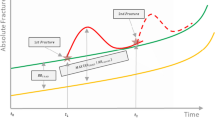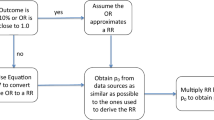Abstract
Background
Survival modeling techniques are increasingly being used as part of decision modeling for health economic evaluations. As many models are available, it is imperative for interested readers to know about the steps in selecting and using the most suitable ones. The objective of this paper is to propose a tutorial for the application of appropriate survival modeling techniques to estimate transition probabilities, for use in model-based economic evaluations, in the absence of individual patient data (IPD). An illustration of the use of the tutorial is provided based on the final progression-free survival (PFS) analysis of the BOLERO-2 trial in metastatic breast cancer (mBC).
Methods
An algorithm was adopted from Guyot and colleagues, and was then run in the statistical package R to reconstruct IPD, based on the final PFS analysis of the BOLERO-2 trial. It should be emphasized that the reconstructed IPD represent an approximation of the original data. Afterwards, we fitted parametric models to the reconstructed IPD in the statistical package Stata. Both statistical and graphical tests were conducted to verify the relative and absolute validity of the findings. Finally, the equations for transition probabilities were derived using the general equation for transition probabilities used in model-based economic evaluations, and the parameters were estimated from fitted distributions.
Results
The results of the application of the tutorial suggest that the log-logistic model best fits the reconstructed data from the latest published Kaplan–Meier (KM) curves of the BOLERO-2 trial. Results from the regression analyses were confirmed graphically. An equation for transition probabilities was obtained for each arm of the BOLERO-2 trial.
Conclusions
In this paper, a tutorial was proposed and used to estimate the transition probabilities for model-based economic evaluation, based on the results of the final PFS analysis of the BOLERO-2 trial in mBC. The results of our study can serve as a basis for any model (Markov) that needs the parameterization of transition probabilities, and only has summary KM plots available.





Similar content being viewed by others
References
Briggs AH, Claxton K, Sculpher MJ. Decision modelling for health economic evaluation. Oxford: Oxford University Press; 2006.
Goeree R, Diaby V. Introduction to health economics and decision-making: is economics relevant for the frontline clinician? Best Pract Res Clin Gastroenterol. 2013;27(6):831–44.
Latimer NR. Survival analysis for economic evaluations alongside clinical trials—extrapolation with patient-level data: inconsistencies, limitations, and a practical guide. Med Decis Making. 2013;33(6):743–54.
Piccart M, Baselga J, Noguchi S, Burris H, Gnant M, Hortobagyi G, et al. Final progression-free survival analysis of BOLERO-2: a phase III trial of everolimus for postmenopausal women with advanced breast cancer [poster]. Cancer Res. 2012;72(24 Suppl.):492–3s (Abstract P6-04-02). Supplemental file available at: http://e-syllabus.gotoper.com/_media/_pdf/MBC13_P6-04-02_Piccart.pdf.
Stevenson M, Street R, Jones ML, Kearns B, Street S, Littlewood C, et al. Cabazitaxel for the second-line treatment of hormone refractory, metastatic prostate cancer: a single technology appraisal. ScHARR: The University of Sheffield; 2011.
Ghosh K, Tiwari RC. Nonparametric and semiparametric Bayesian reliability analysis. In: Ruggeri F, Kenett R, Faltin FW, editors. Encyclopedia of statistics in quality and reliability. Chichester, UK: Wiley; 2007. p. 1239–1248.
Coon JT, Hoyle M, Green C, Liu Z, Welch K, Moxham T, et al. Bevacizumab, sorafenib tosylate, sunitinib and temsirolimus for renal cell carcinoma: a systematic review and economic evaluation. Health Technol Assess. 2010;14:1–208.
Rogers G, Hoyle M, Coon JT, Moxham T, Liu Z, Pitt M, et al. Dasatinib and nilotinib for imatinib-resistant or -intolerant chronic myeloid leukaemia: a systematic review and economic evaluation. Health Technol Assess. 2012;16(22):1–410. doi:10.3310/hta16220.
Guyot P, Ades AE, Ouwens MJNM, Welton NJ. Enhanced secondary analysis of survival data: reconstructing the data from published Kaplan–Meier survival curves. BMC Med Res Methodol. 2012;12:9.
Baselga J, Campone M, Piccart M, Burris HA 3rd, Rugo HS, Sahmoud T, et al. Everolimus in postmenopausal hormone-receptor-positive advanced breast cancer. N Engl J Med. 2012;366(6):520–9.
Qi JZ. Comparison of proportional hazards and accelerated failure time models. Dissertation, University of Saskatchewan; 2009. p. 89. Available at http://ecommons.usask.ca/bitstream/handle/10388/etd-03302009-140638/JiezhiQiThesis.pdf.
Akaike H. A new look at the statistical model identification. IEEE Trans Autom Contr. 1974;19(6):716–23.
Schwarz G. Estimating the dimension of a model. Ann Stat. 1978;6(2):461–4.
Moeschberger ML, Klein JP. Survival analysis: techniques for censored and truncated data. Berlin: Springer; 2003.
Royston P, Lambert PC. Flexible parametric survival analysis using stata: beyond the Cox model. College Station: Stata Press; 2011.
Jackson CH, Sharples LD, Thompson SG. Survival models in health economic evaluations: balancing fit and parsimony to improve prediction. Int J Biostat. 2010;6(1):34.
Acknowledgments
The author contributions are presented below.
Study concept and design: Vakaramoko Diaby, Georges Adunlin, and Alberto J. Montero.
Data acquisition: Vakaramoko Diaby, Georges Adunlin.
Data analyses and interpretation: Vakaramoko Diaby.
Drafting of the article: Vakaramoko Diaby, Georges Adunlin, and Alberto J. Montero drafted the manuscript.
Revision for intellectual content: All Authors.
Guarantor: Vakaramoko Diaby.
The authors are grateful to Dr. Patricia Guyot for her help in the implementation of the algorithm in the statistical package R. The authors would also like to thank Moussa K. Richard, Gordon Blackhouse, Dr. Robert Hopkins, and Askal Ali for their insightful comments on earlier versions of the paper.
Conflict of interests
Dr. Vakaramoko Diaby, Georges Adunlin, and Dr. Alberto J. Montero certifies that they have no conflicts of interest with any financial organization regarding the material discussed in the manuscript.
Author information
Authors and Affiliations
Corresponding author
Electronic supplementary material
Below is the link to the electronic supplementary material.
Rights and permissions
About this article
Cite this article
Diaby, V., Adunlin, G. & Montero, A.J. Survival Modeling for the Estimation of Transition Probabilities in Model-Based Economic Evaluations in the Absence of Individual Patient Data: A Tutorial. PharmacoEconomics 32, 101–108 (2014). https://doi.org/10.1007/s40273-013-0123-9
Published:
Issue Date:
DOI: https://doi.org/10.1007/s40273-013-0123-9




